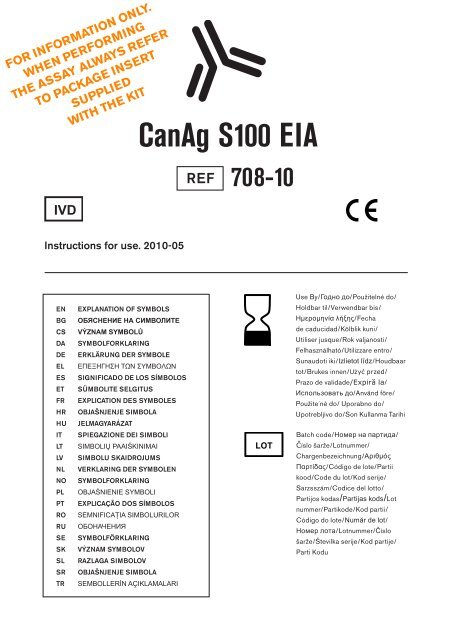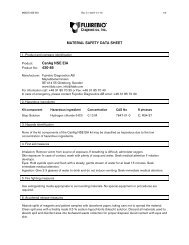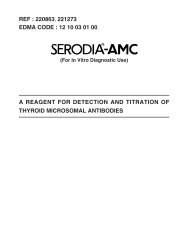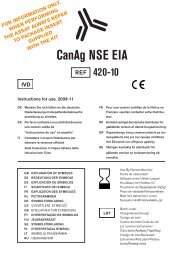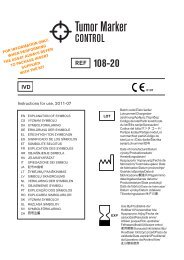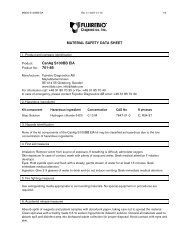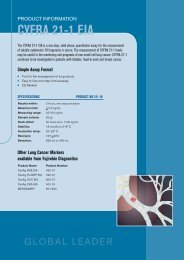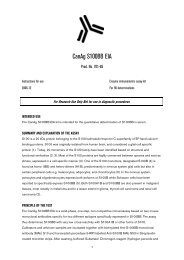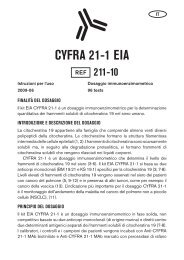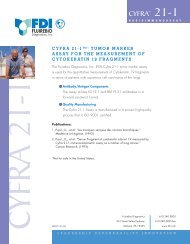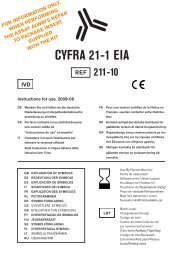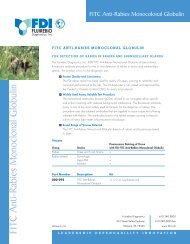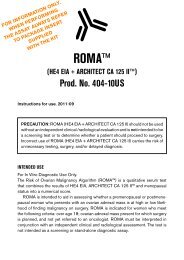canag s100 eia - full package insert - Fujirebio Diagnostics, Inc.
canag s100 eia - full package insert - Fujirebio Diagnostics, Inc.
canag s100 eia - full package insert - Fujirebio Diagnostics, Inc.
You also want an ePaper? Increase the reach of your titles
YUMPU automatically turns print PDFs into web optimized ePapers that Google loves.
FOR INFORMATION ONLY.<br />
WHEN PERFORMING<br />
THE ASSAY ALWAYS REFER<br />
TO PACKAGE INSERT<br />
SUPPLIED<br />
WITH THE KIT<br />
IVD<br />
CanAg S100 EIA<br />
REF 708-10<br />
Instructions for use. 2010-05<br />
EN<br />
BG<br />
CS<br />
DA<br />
DE<br />
EL<br />
ES<br />
ET<br />
FR<br />
HR<br />
HU<br />
IT<br />
LT<br />
LV<br />
NL<br />
NO<br />
PL<br />
PT<br />
RO<br />
RU<br />
SE<br />
SK<br />
SL<br />
SR<br />
TR<br />
EXPLANATION OF SYMBOLS<br />
ОБЯСНЕНИЕ НА СИМВОЛИТЕ<br />
VÝZNAM SYMBOLŮ<br />
SYMBOLFORKLARING<br />
ERKLÄRUNG DER SYMBOLE<br />
ΕΠΕΞΗΓΗΣΗ ΤΩΝ ΣΥΜΒΟΛΩΝ<br />
SIGNIFICADO DE LOS SÍMBOLOS<br />
SÜMBOLITE SELGITUS<br />
EXPLICATION DES SYMBOLES<br />
OBJAŠNJENJE SIMBOLA<br />
JELMAGYARÁZAT<br />
SPIEGAZIONE DEI SIMBOLI<br />
SIMBOLIŲ PAAIŠKINIMAI<br />
SIMBOLU SKAIDROJUMS<br />
VERKLARING DER SYMBOLEN<br />
SYMBOLFORKLARING<br />
OBJAŚNIENIE SYMBOLI<br />
EXPLICAÇÃO DOS SÍMBOLOS<br />
SEMNIFICAŢIA SIMBOLURILOR<br />
ОБОНАЧЕНИЯ<br />
SYMBOLFÖRKLARING<br />
VÝZNAM SYMBOLOV<br />
RAZLAGA SIMBOLOV<br />
OBJAŠNJENJE SIMBOLA<br />
SEMBOLLERİN AÇIKLAMALARI<br />
Use By/Годно до/Použitelné do/<br />
Holdbar til/Verwendbar bis/<br />
Ημερομηνία λήξης/Fecha<br />
de caducidad/Kõlblik kuni/<br />
Utiliser jusque/Rok valjanosti/<br />
Felhasználható/Utilizzare entro/<br />
Sunaudoti iki/Izlietot līdz/Houdbaar<br />
tot/Brukes innen/Użyć przed/<br />
Prazo de validade/Expiră la/<br />
Использовать до/Använd före/<br />
Použite´né do/ Uporabno do/<br />
Upotrebljivo do/Son Kullanma Tarihi<br />
Batch code/Номер на партида/<br />
Číslo šarže/Lotnummer/<br />
Chargenbezeichnung/Αριθμός<br />
Παρτίδας/Código de lote/Partii<br />
kood/Code du lot/Kod serije/<br />
Sarzsszám/Codice del lotto/<br />
Partijos kodas/Partijas kods/Lot<br />
nummer/Partikode/Kod partii/<br />
Código do lote/Număr de lot/<br />
Номер лота/Lotnummer/Číslo<br />
šarže/Številka serije/Kod partije/<br />
Parti Kodu<br />
1
IVD<br />
REF<br />
Date of manufacture/Дата на<br />
производство/Datum výroby/<br />
Produktionsdato/Herstellungsdatum/<br />
Ημερομηνία παραγωγής/Fecha de<br />
fabricación/Valmistamise kuupäev/<br />
Date de fabrication/Datum proizvodnje/<br />
Gyártási idő/Data di produzione/<br />
Pagaminimo data/Ražošanas datums/<br />
Productiedatum/Fremstillingsdato/<br />
Data produkcji/Data de fabrico/Data<br />
fabricaţiei/Дата производства/<br />
Tillverkningsdatum/Dátum výroby/Datum<br />
izdelave/Datum proizvodnje/Üretim tarihi<br />
In Vitro Diagnostic Medical Device/<br />
Медицински уред за диагностика<br />
ин витро/Lékařský přístroj pro<br />
diagnostiku in vitro/Medicinsk udstyr til<br />
in vitro-diagnostik/In-vitro-Diagnostikum/<br />
Ιατροτεχνολογικό προϊόν για διάγνωση<br />
In Vitro/Dispositivo médico para<br />
diagnóstico in vitro/In vitro diagnostiline<br />
meditsiiniseade/Dispositif médical<br />
de diagnostic in vitro/Diagnostički<br />
medicinski uređaj In Vitro/In vitro<br />
orvosdiagnosztikai eszköz/Dispositivo<br />
medico per test diagnostici in vitro/In<br />
Vitro Diagnostinė Medicinos Priemonė/<br />
Medicīniska ierīce in vitro diagnostikai/<br />
In vitro-diagnostisch medisch instrument/<br />
In vitro diagnostisk medisinsk utstyr/<br />
Wyrób medyczny do diagnostyki in vitro/<br />
Dispositivo Médico de Diagnóstico In<br />
Vitro/Dispozitiv medical pentru diagnostic<br />
in vitro/Только для диагностики In<br />
Vitro/Endast för in vitro-diagnostik/<br />
Zdravotnícka pomôcka na diagnostiku in<br />
vitro/In vitro diagnostični pripomoček/<br />
Diagnostički medicinski uređaj In<br />
Vitro/ testleri için yeterlilik içerir<br />
Catalogue number/Каталожен номер/<br />
Katalogové číslo/Katalognummer/<br />
Bestellnummer/Αριθμός καταλόγου/<br />
Número de catálogo/Kataloogi number/<br />
Numéro de catalogue/Kataloški broj/<br />
Katalógusszám/Numero di catalogo/<br />
Katalogo numeris/Numurs katalogā/<br />
Catalogusnummer/Katalognummer/<br />
Numer katalogowy/Número do catálogo/<br />
Număr de catalog/Номер по каталогу/<br />
Produktnummer/Katalógové číslo/<br />
Kataloška številka/Kataloški broj/<br />
Katalog numarası<br />
2 o C<br />
8 o C<br />
Temperature limitation/<br />
Температурни граници/<br />
Teplotní omezení/<br />
Temperaturbegrænsning/<br />
Temperaturbegrenzung/<br />
Περιορισμοί θερμοκρασίας/<br />
Límites de temperatura/<br />
Temperatuuri piirang/<br />
Limite de température/<br />
Temperaturno ograničenje/<br />
Hőmérsékletre vonatkozó korlátozás/<br />
Limiti di temperatura/<br />
Temperatūriniai apribojimai/<br />
Temperatūras ierobežojums/<br />
Temperatuurbeperking/<br />
Temperaturbegrensninger/<br />
Temperatury graniczne/<br />
Limite de temperatura/<br />
Limite de temperatură/<br />
Температурный режим/<br />
Temperaturbegränsning/<br />
Teplotné obmedzenie<br />
Omejitev temperature/<br />
Temperaturno ograničenje/<br />
Sıcaklık sınırlaması/<br />
Contains sufficient for tests/Съдържа<br />
достатъчно количество за тестове<br />
/Lze použit pro testů/Indeholder<br />
tilsttrækkeligt/Inhalt ausreichend für <br />
Prüfungen/Περιεχόμενο επαρκές για<br />
«96» εξετάσεις/Contenido suficiente para<br />
ensayos/Kogusest piisab testi<br />
läbiviimiseks/Contenu suffisant pour “96”<br />
tests/Sadrži dovoljno za testova/A<br />
doboz tartalma vizsgálat elvégzéséhez<br />
elegendő/Contenuto sufficiente per “96”<br />
saggi/Turinys skirtas atlikti tyrimus/<br />
Saturs pietiekams testiem/Inhoud<br />
voldoende voor “96” testen/til ”96” test/<br />
Tilstrekkelig innhold for prøver/<br />
Wystarczy na wykonanie testów/<br />
Conteúdo suficiente para “96” ensaios/<br />
Conţinut suficient pentru 96 de teste/<br />
Содержит достаточные количества для<br />
«96» определений/Innehåller tillräckligt<br />
till “96” antal tester/Obsah postačuje na<br />
tento počet testov: /Vsebina zadostuje<br />
za testov/Sadržina dovoljna za <br />
testova/ testleri için yeterlilik içerir<br />
2
CONT<br />
Consult Instructions for Use/<br />
Прочетете инструкцията за<br />
употреба/Konzultujte s návodem<br />
k použití/Se brugsanvisning/Siehe<br />
Gebrauchsanweisung/Συμβουλευτείτε<br />
τις Οδηγίες σχετικά με τη χρήση/<br />
Consulte las instrucciones de uso/<br />
Vt kasutusjuhendit/Consulter le mode<br />
d’emploi/Pročitajte upute za uporabu/<br />
Olvassa el a használati utasítást/<br />
Consultare le istruzioni per l’uso/Dėl<br />
naudojimo žiūrėkite instrukcijas/Izlasiet<br />
lietošanas instrukciju/Raadpleeg de<br />
instructies voor gebruik/Les instruksene<br />
før bruk/Sprawdzić w instrukcji użycia/<br />
Consulte as Instruções de Utilização/<br />
Consultaţi instrucţiunile de utilizare/<br />
Обратитесь к инструкции по<br />
применению/Se bruksanvisning/<br />
Prečítajte si návod na používanie/<br />
Pročitajte uputstvo za upotrebu/<br />
Kullanım Talimatlarına Bakınız<br />
Contents of kit/Съдържание на набора/<br />
Obsah sady/Kittets indhold/Inhalt des<br />
Kits/Περιεχόμενα του κιτ/Contenido<br />
del kit/Komplekt sisaldab/Contenu du<br />
kit/Sadržaj opreme/A készlet tartalma/<br />
Contenuto del kit/Rinkinio turinys/<br />
Komplekta saturs/Inhoud van de set/<br />
Settets innhold/Zawartość zestawu/<br />
Conteúdo do kit/Conţinutul setului/<br />
Компоненты набора/Kit innehåll/<br />
Obsah súpravy/Vsebina kompleta/Sadržaj<br />
opreme/Kitin içindekiler<br />
Biological risks/Биологическа<br />
опасност/Biologická rizika/Biologisk<br />
fare/Biologische Gefahren/Βιολογικοί<br />
κίνδυνοι/Riesgos biológicos/<br />
Bioloogilised ohud/Risques biologiques/<br />
Biološkli rizici/Biológiai kockázatok/Rischi<br />
biologici/Biologinis pavojus/Bioloģiskais<br />
risks/Biologische risico’s/Biologiske<br />
risikoer/Zagrożenie biologiczne/Riscos<br />
biológicos/ Biologisk risk/Pericole<br />
biologice/Биологическая опасность/<br />
Biologicky rizikové/Biologické riziká/<br />
Biološkli rizici/Biyolojik riskler<br />
ORIG<br />
ORIG<br />
ORIG<br />
<br />
HUM<br />
MOU<br />
BOV<br />
Human/С човешки произход/Lidské/<br />
Humant/Human/δείγματα αναφοράς/<br />
Humano/Inimpäritolu/Humaine/Ljudskog<br />
porjekla/Humán/Origine Umana/<br />
Žmogaus kilmės/Cilvēku izcelsmes/<br />
Human/Menneske/Ludzka/Humano/<br />
Origine umană/Человеческого<br />
происхождения/Human/Ľudské/<br />
Humanega izvora/Ljudskog porekla/İnsan<br />
From mouse/С миши произход/Myší/<br />
Fra mus/der Maus/απο ποντίκι/de ratón/<br />
Hiirtelt/De souris/Mišijeg porjekla/<br />
Egérből/Murino/Pelės kilmės/No peles/<br />
Van muizen/Fra mus/Mysia/Do rato/De<br />
la şoareci/Мышиного происхождения/<br />
Från mus/Myšie/Mišjega izvora/Mišijeg<br />
porekla/Fareden<br />
Bovine/С говежди произход/<br />
Hovězí/Bovin/Rind/από βοοειδή/<br />
Bovino/Veistelt/Bovine/Rogate stoke/<br />
Szarvasmarha/Bovino/Jaučio/No<br />
liellopa/Bovien/Bovin/Wołowy/Bovino/<br />
Origine bovină/крупного рогатого<br />
скота/Från ko/Hovädzie/Govejega<br />
izvora/Rogate krupne stoke/Bovin<br />
Reconstitute with/Разтваряне с/<br />
Rozřeďte pomocí/Rekonstitueres med/<br />
Rekonstituieren mit/Ανασύσταση με/<br />
Reconstituir con/Lahjendamine/<br />
Reconstituer avec/Rekonstituirajte s/<br />
Feloldáshoz/Ricostituire con/LT/Atšķaidīt<br />
ar/Reconstitutie met/Rekonstitueres<br />
med/Odtworzyć za pomocą/Reconstituir<br />
com/A se reconstitui cu/Растворить в/<br />
Rekonstituera med/Rozrieďte pomocou/<br />
Rekonstituirajte z/s/Ponovno formiranje<br />
sa/Yeniden oluşturulur<br />
Manufacturer/Производител/Výrobce/<br />
Producent/Hersteller/Kτασκευαστής/<br />
Fabricante/Tootja/Fabricant/Proizvođač/<br />
Gyártó/Fabbricante/Gamintojas/<br />
Ražotājs/Fabrikant/Produsent/<br />
Producent/Fabricante/Producător/<br />
Производитель/Tillverkare/ Výrobca/<br />
Izdelovalec/Proizvođač/Üretici<br />
3
WARNINGS AND PRECAUTIONS<br />
For in vitro diagnostic use<br />
• For Professional Use Only.<br />
• Please refer to the U.S. Department of Health and Human Services (Bethesda, Md., USA) publication No.<br />
(CDC) 88—8395 on laboratory safety procedures or any other local or national regulation.<br />
• Handle all patient specimens as potentially infectious.<br />
• Reagents contain sodium azide (NaN 3<br />
) as a preservative. Sodium azide may react with lead and copper<br />
plumbing to form highly explosive metal azides. On disposal, flush with a large volume of water to prevent<br />
azide build-up.<br />
• Follow local guidelines for disposal of all waste material.<br />
ADVARSLER OG FORHOLDSREGLER<br />
Til in vitro diagnostisk anvendelse<br />
• Kun til professionel brug.<br />
• Der henvises til U.S. Department of Health and Human Services (de amerikanske sundhedsmyndigheder)<br />
(Bethesda, Md., USA) udgivelse nr. (CDC) 88-8395 vedrørende laboratoriesikkerhedsprocedurer eller<br />
andre lokale eller nationale forskrifter.<br />
• Alle patientprøver skal behandles som potentielt smittefarlige.<br />
• Reagenser indeholder natriumazid som præserveringsmiddel. Natriumazid kan danne eksplosive syrer i<br />
metalafløb. Anvend korrekt affaldsprocedure.<br />
• Følg lokale regler for afskaffelse af alt affald.<br />
VORSICHTSMASSNAHMEN<br />
Nur zur in vitro-Diagnostik zu verwenden<br />
• Nur für geschultes Fachpersonal.<br />
• Bitte beachten Sie die Vorschriften zur Laborsicherheit in der Publikation Nr. (CDC) 88-8395 des<br />
US Department of Health and Human Services (Bethesda, MD, USA) oder andere gleichwertige regionale<br />
oder nationale Bestimmungen.<br />
• Behandeln Sie sämtliche Probe mit Vorsicht – Sie sind potentiell infektiös.<br />
• Die Reagenzien enthalten Natriumazid (NaN 3<br />
) als Konservierungsmittel. Natriumazid kann mit Blei- und<br />
Kupferleitungen reagieren und hochexplosive Metallazide bilden. Spülen Sie die Leitungen beim Wegschüt<br />
ten mit viel Wasser, um einer Azidbildung vorzubeugen.<br />
• Behörde oder Abfallbeseitigungsunternehmen informieren über die Entsorgung von Sonderabfällen.<br />
ΠΡΟΕΙΔΟΠΟΙΗΣΕΙΣ ΚΑΙ ΠΡΟΦΥΛΑΞΕΙΣ<br />
Για in vitro διαγνωσική χρήση<br />
EN<br />
• Για επαγγελµατική χρήση, µόνο.<br />
• Παρακαλούμαι όπως επικαλεστείτε τις οδηγίες ασφαλούς λειτουγίας των εργαστηρίων του Τμήματος<br />
Υγείας και Ανθρωπινων Υπηρεσιών των Η.Π.Α.(U.S. Department of Health and Human Services)<br />
(Bethesda, Md., USA) αριθμός έκδοσης (CDC) 88—8395, ή οποιοδήποτε άλλο κατά τόπους σχετικό<br />
Εθνικό κανονισμό.<br />
• Μεταχειριστήτε όλα τα δείγματα ως μολυσμένα.<br />
• Αποφύγετε επαφή με αντιδραστήρια που περιέχουν υπεροξείδιο του υδρογόνου ή υδροχλωρικό οξύ.<br />
Σε περίπτωση επαφής με τέτοιου είδους αντιδραστήρια, πλυθείτε σχολαστικά με άφθονο νερό.<br />
• Ακολουθείστε τις κατά τόπου οδηγίες για απομάκρυνση άχρηστου υλικού.<br />
DA<br />
DE<br />
EL<br />
4
CUIDADOS Y PRECAUCIONES<br />
Para diagnóstico in vitro<br />
• Solo para uso profesional<br />
• Consultar la publicación del U.S. Department of Health and Human Services (Bethesda, Md., USA publication<br />
No. (CDC) 88—8395 o las normas locales o nacionales.<br />
• Tratar todas las muestras de pacientes como potencialmente infecciosas.<br />
• Los reactivos contienen azida sódica (NaN 3<br />
) come conservante. La azida sódica puede reaccionar con el<br />
plomo o el cobre de las tuberías, formando azidas metálicas muy explosivas. Al limpiar los reactivos, dejar<br />
correr gran cantidad de agua para evitar la formación de azidas.<br />
• Todos los residuos se deben tirar cumpliendo las normas en vigor.<br />
PRÉCAUTIONS D’EMPLOI ET MISE EN GARDE<br />
Pour un usage diagnostic in Vitro<br />
• Pour usage professionnel seulement.<br />
• Prière de se référer à la Publication N° : (CDC) 88-8395 de l’U.S. Départment of Health and Human Services<br />
(Béthesda, Md., USA) sur les procédures de sécurité dans les laboratoires ou toutes autres réglementations<br />
locales et nationales.<br />
• Manipuler les échantillons de patients comme potentiellement infectieux.<br />
• Réactifs contenant de l’Azide de Sodium (NaN3) comme conservateur: l’Azide de Sodium peut réagir avec<br />
les tubes en plomb et en cuivre pour former des Azides de métaux hautement explosifs. Lors de<br />
l’élimination, répandre une grande quantité d’eau pour prévenir la formation des Azides.<br />
• Suivre les réglementations locales pour l’élimination et le traitement de tous les déchets.<br />
AVVERTENZE E PRECAUZIONI<br />
Per uso diagnostico in vitro<br />
• Solamente per uso professionale.<br />
• Come riferimento si consiglia la pubblicazione No. ( CDC ) 88-8395 del US Department of Health and<br />
Human Service o qualsiasi altro regolamento locale o nazionale relativo alle Norme di Sicurezza da seguire<br />
nei Laboratori Diagnostici.<br />
• Maneggiare I campioni dei pazienti come potenzialmente infetti.<br />
• I reattivi contengono sodio azide ( NaN3) come conservante. Il sodio azide può reagire con piombo e rame<br />
formando azidi metallici altamente esplosivi. Quando i reattivi vengono scartati lavare con abbondante<br />
quantità di acqua per prevenire il rischio di reazione dell’azide.<br />
• Seguire le normative vigenti relative all’eliminazione del materiale usato.<br />
VARNINGAR OCH SÄKERHETSÅTGÄRDER<br />
Endast för in vitro diagnostik<br />
• Endast för professionellt bruk.<br />
• Följ “U.S. Department of Health and Human Services (Bethesda, Md., USA) publikation (CDC) 88—8395”<br />
eller annan lokal eller nationell bestämmelse beträffande laboratoriesäkerhet.<br />
• Hantera alla patientprover som potentiellt smittsamma.<br />
• Vissa reagens innehåller natriumazid (NaN 3<br />
) som konserveringsmedel. Natriumazid kan reagera med blyoch<br />
kopparledningar och bilda explosiva metall-azider. Använd rikligt med vatten vid nedspolning i avloppet<br />
för att förhindra metall-azid bildning.<br />
• Följ lokala bestämmelser för bortskaffande av avfall.<br />
ES<br />
FR<br />
IT<br />
SE<br />
5
CanAg S100 EIA<br />
EN<br />
Instructions for use<br />
Enzyme immunometric assay kit<br />
For 96 determinations<br />
INTENDED USE<br />
The CanAg S100 EIA kit is intended for the quantitative determination of S100B<br />
(S100A1B + S100BB) in serum.<br />
SUMMARY AND EXPLANATION OF THE ASSAY<br />
S100 is a 20 kDa protein belonging to the S100/calmodulin/troponin C superfamily<br />
of EF-hand calcium-binding proteins. S100 was originally isolated from human<br />
brain and considered a glial-cell specific protein (1). Today, 20 monomers of the<br />
S100 family have been identified based on structural and functional similarities (2,<br />
3). Most of the S100 proteins exist as dimers and are expressed in a cell-specific<br />
manner. Two of the S100 monomers, designated S100A1 and S100B (4) are highly<br />
conserved between species and are found as homo- (BB) and heterodimers (A1B)<br />
in central nervous system glial cells and in certain peripheral cells eg. Schwann<br />
cells, melanocytes, adipocytes, and chondrocytes (5). S100A1B and S100BB are<br />
also present in malignant tissues, most notably in melanoma and to a lesser extent<br />
in glioma, thyroid cell carcinoma and renal cell carcinoma (2).<br />
Determination of S100B in serum has been shown to be clinically useful for<br />
prognosis and treatment monitoring of patients diagnosed with malignant melanoma<br />
(6-9). Studies also suggest that S100B may be useful in the management of patients<br />
with brain damage from eg. traumatic head injury, perinatal asphyxia, cardiac arrest,<br />
cardiac surgery and stroke (10-13).<br />
PRINCIPLE OF THE TEST<br />
The CanAg S100 EIA is a solid-phase, two-step, non-competitive immunoassay based<br />
on two mouse monoclonal antibodies specific for two different epitopes expressed in<br />
S100B. The assay determines both S100A1B and S100BB without cross-reactivity<br />
with other forms of S100. Calibrators and patient samples are incubated together<br />
with biotinylated Anti-S100B monoclonal antibody (MAb) S23 in Streptavidin coated<br />
microstrips. S100B present in calibrators or samples is adsorbed to the Streptavidin<br />
coated microwells by the biotinylated Anti-S100B MAb during the incubation. The<br />
strips are then washed and incubated with horseradish peroxidase (HRP) labelled<br />
Anti-S100B MAb S53. After washing, buffered Substrate/ Chromogen reagent<br />
(hydrogen peroxide and 3, 3’, 5, 5’ tetra-methylbenzidine) is added to each well<br />
and the enzyme reaction is allowed to proceed. During the enzyme reaction a blue<br />
6
colour will develop if antigen is present. The intensity of the colour is proportional<br />
to the amount of S100B present in the samples.<br />
The colour intensity is determined in a microplate spectrophotometer at 620 nm<br />
(or optionally at 405 nm after addition of Stop Solution). Calibration curves are<br />
constructed for each assay by plotting absorbance value versus the concentration<br />
for each calibrator. The S100B concentrations of patient samples are then read<br />
from the calibration curve.<br />
REAGENTS<br />
• Each CanAg S100 EIA kit contains reagents for 96 tests.<br />
• The expiry date of the kit is stated on the label on the outside of the kit box.<br />
• Do not use the kit beyond the expiry date.<br />
• Do not mix reagents from different kit lots.<br />
• Store the kit at 2–8°C. Do not freeze.<br />
• Opened reagents are stable accordning to the table below provided they are<br />
not contaminated, stored in resealed original containers and handled as prescribed.<br />
Return to 2-8°C immediately after use.<br />
Component Quantity Storage and stability<br />
after first opening<br />
MICROPLA<br />
Microplate 1 Plate 2—8°C until expiry<br />
date stated on the plate<br />
12 x 8 wells coated with Streptavidin. After opening, immediately return unused strips<br />
to the aluminium pouch, containing desiccant. Reseal care<strong>full</strong>y to keep dry.<br />
S100 Calibrators<br />
CAL S100 A<br />
CAL S100 B<br />
CAL S100 C<br />
CAL S100 D<br />
6 vials, lyophilized<br />
1 x 1 mL<br />
1 x 1 mL<br />
1 x 1 mL<br />
1 x 1 mL<br />
4 weeks at 2–8° C<br />
3 months at –30° C or below<br />
7
Component Quantity Storage and stability<br />
after first opening<br />
CAL S100 E<br />
1 x 1 mL<br />
CAL S100 F<br />
1 x 1 mL<br />
The lyophilised calibrators contain bovine S100B in a protein matrix with 0.02%<br />
NaN3 as preservative. To be reconstituted with water before use. NOTE: The exact<br />
S100B concentration is lot specific and is indicated on the label of each vial.<br />
BIOTIN<br />
Anti-S100<br />
Biotin Anti-S100 1 x 15 mL 2—8°C until expiry<br />
date stated on the vial<br />
Biotin Anti-S100 monoclonal antibody from mouse, approximately 2 µg/mL. Contains<br />
phosphate buffered saline (pH 7.2) with CaCl 2<br />
, bovine serum albumin, bovine<br />
immunoglobulin, blocking agents, Tween 20, an inert blue dye and 0.01% methylisothiazolone<br />
(MIT) as preservative. Ready for use.<br />
CONJ<br />
Anti-S100<br />
Tracer, HRP Anti-S100 1 x 0.75 mL 2—8°C until expiry<br />
date stated on the vial<br />
Stock solution of HRP Anti-S100 monoclonal antibody from mouse, approximately<br />
20 µg/mL. Contains preservatives. To be diluted with Tracer Diluent before use.<br />
DIL<br />
CONJ<br />
Tracer Diluent 1 x 15 mL 2—8°C until expiry<br />
date stated on the vial<br />
Phosphate buffered saline (pH 7.2) with bovine serum albumin, blocking agents,<br />
detergents, an inert blue dye, and 0.01 % methyl-isothiazolone (MIT) as preservative.<br />
Ready for use.<br />
8
Component Quantity Storage and stability<br />
after first opening<br />
SUBS TMB<br />
TMB HRP-Substrate 1 x 12 mL 2—8°C until expiry<br />
date stated on the vial<br />
Contains buffered hydrogen peroxide and 3, 3’, 5, 5’ tetramethyl-benzidine (TMB).<br />
Ready for use.<br />
STOP<br />
STOP Solution 1 x 15 mL 2—8°C until expiry<br />
date stated on the vial<br />
Contains 0.12 M hydrochloric acid. Ready for use.<br />
WASHBUF<br />
25X<br />
Wash Concentrate 1 x 50 mL 2—8°C until expiry<br />
date stated on the bottle<br />
A Tris-HCl buffered salt solution with Tween 20. Contains Germall II as preservative.<br />
To be diluted with water 25 times before use.<br />
Indications of instability<br />
The TMB HRP-Substrate should be colourless or slightly bluish. A blue colour<br />
indicates that the reagent has been contaminated and should be discarded.<br />
WARNINGS AND PRECAUTIONS<br />
For in vitro diagnostic use.<br />
• For professional use only.<br />
• Please refer to the US Department of Health and Human Services<br />
(Bethesda, Md., US) publication No. (CDC) 88-8395 on laboratory safety or<br />
any other local or national regulation.<br />
• Handle all patient specimens as potentially infectious.<br />
• Reagents contain sodium azide (NaN 3<br />
) as a preservative. Sodium azide may<br />
react with lead and copper plumbing to form highly explosive metal azides.<br />
On disposal, flush with a large volume of water to prevent azide build-up.<br />
• Follow local guidelines for disposal of all waste material.<br />
9
SPECIMEN COLLECTION AND HANDLING<br />
The CanAg S100 EIA is intended for use with serum. Collect blood by venipuncture<br />
and separate the serum according to common procedures. Samples can be stored<br />
at 2–8° C for 24 hours. For longer periods it is recommended to store the samples<br />
at –20°C or below. Avoid repeated freezing and thawing of the samples. Allow<br />
frozen samples to thaw slowly, preferably at 2–8° C over night and then bring the<br />
samples to room temperature before analysis.<br />
PROCEDURE<br />
Materials required but not supplied with the kit<br />
1. Microplate shaker<br />
Shaking should be medium to vigorous. Longitudinal shaking approximately<br />
200 strokes/min, oscillations 700-900/min.<br />
2. Microplate wash device<br />
Automatic plate wash capable of performing 1 and 6 washing cycles with a<br />
minimal fill volume of 350 µL/well/washcycle.<br />
The Nunc Immuno-8 manual strip washer is recommended if an automatic<br />
microplatewash is not used.<br />
3. Microplate spectrophotometer<br />
With a wavelength of 620 nm and/or 405 nm and an absorbance range of<br />
0 to 3.0.<br />
4. Precision pipettes<br />
With disposable plastic tips to deliver microlitre and millilitre volumes.<br />
An 8-channel pipette or respenser pipette with disposable plastic tips<br />
for delivery of 100 µL is useful but not essential.<br />
5. Distilled or deionized water<br />
For reconstitution of S100 Calibrators and for preparation of Wash Solution.<br />
10
Procedural notes<br />
1. A thorough understanding of this <strong>package</strong> <strong>insert</strong> is necessary to ensure proper<br />
use of the CanAg S100 EIA kit. The reagents supplied with the kit are intended<br />
for use as an integral unit. Do not mix identical reagents from kits having<br />
different lot numbers. Do not use the kit reagents after the expiry date printed<br />
on the outside of the kit box.<br />
2. Reagents should be allowed to reach room temperature (20–25°C) prior to<br />
use. The assay should only be performed at temperatures between 20–25°C to<br />
obtain accurate results. Frozen specimens should be brought to room temperature<br />
slowly and must be gently but thoroughly mixed after thawing.<br />
3. Before starting to pipette calibrators and patient specimens it is<br />
advisable to mark the strips to be able to clearly identify the samples during<br />
and after the assay.<br />
4. The requirement for efficient and thorough washing for separation of bound and<br />
unbound antigen and reagents from the solid-phase bound antibody-antigen<br />
complexes is one of the most important steps in an EIA. In order to ensure<br />
efficient washing make sure that all wells are completely filled to the top edge<br />
with wash solution during each wash cycle, that wash solution is dispensed<br />
at a good flow rate, that the aspiration of the wells between and after the wash<br />
cycles is complete and that the wells are empty. If there is liquid left, invert the<br />
plate and tap it care<strong>full</strong>y against absorbent paper.<br />
- Automatic strip washer: Follow the manufacturer’s instructions for cleaning<br />
and maintenance diligently and wash the required number of wash cycles<br />
prior to and after each incubation step. It’s highly recommended to<br />
use strip process mode and overflow wash mode with a dispensing<br />
volume of 800 µL. The aspiration/wash device should not be left standing<br />
with the Wash Solution for long periods, as the needles may get<br />
clogged resulting in poor liquid delivery and aspiration.<br />
5. The TMB HRP-Substrate is very sensitive for contamination. For optimal stability<br />
of the TMB HRP-Substrate, pour the required amount from the vial to a care<strong>full</strong>y<br />
cleaned reservoir or preferably a disposable plastic tray to avoid contamination<br />
of the reagent. Be sure to use clean disposable plastic pipette<br />
tips (or respenser pipette tip).<br />
6. Be sure to use clean disposable plastic pipette tips and a proper pipetting<br />
technique when handling samples and reagents. Avoid carry-over by holding<br />
the pipette tip slightly above the top of the well and avoid touching the plastic<br />
strip or surface of the liquid. A proper pipetting technique is of particular<br />
importance when handling the TMB HRP-Substrate Solution.<br />
11
CAL S100<br />
WASHBUF 25X<br />
CONJ<br />
Anti-S100<br />
DIL CONJ<br />
REF<br />
12
MICROPLA<br />
CAL S100<br />
BIOTIN<br />
Anti-S100<br />
MICROPLA<br />
MICROPLA<br />
MICROPLA<br />
MICROPLA<br />
SUBS<br />
TMB<br />
MICROPLA<br />
MICROPLA<br />
STOP<br />
MICROPLA<br />
MICROPLA<br />
13
Preparation of reagents<br />
S100 Calibrators<br />
Stability of prepared reagent<br />
4 weeks at 2–8°C<br />
3 months at –30° C or below<br />
Add exactly 1.0 mL of distilled water to each vial and mix gently. Allow to stand for<br />
at least 15 minutes to reconstitute. NOTE: The concentration of the calibrators is<br />
stated on the labels and should be used for calculation of results.<br />
Wash Solution<br />
2 weeks at 2–25°C in a<br />
sealed container<br />
Pour the 50 mL Wash Concentrate into a clean container and dilute 25- fold by<br />
adding 1200 mL of distilled or deionized water to give a buffered Wash Solution.<br />
Tracer working solution<br />
3 weeks at 2–8°C<br />
in a sealed container<br />
Prepare the required quantity of Tracer working solution by mixing 50 µL of Tracer,<br />
HRP Anti-S100 with 1 mL of Tracer Diluent per strip (see table below):<br />
No. of Tracer, HRP Anti-S100 Tracer Diluent<br />
Strips (µL) (mL)<br />
1 50 1<br />
2 100 2<br />
3 150 3<br />
4 200 4<br />
5 250 5<br />
6 300 6<br />
7 350 7<br />
8 400 8<br />
9 450 9<br />
10 500 10<br />
11 550 11<br />
12 600 12<br />
Be sure to use a clean plastic or glass bottle for preparation of the Tracer working<br />
solution.<br />
Alternative: Pour the content of the Tracer, HRP Anti-S100 into the vial of Tracer<br />
Diluent and mix gently. Make sure that all of the Tracer, HRP Anti-S100 is transferred<br />
to the vial of Tracer Diluent.<br />
14
NOTE: The Tracer working solution is stable for 3 weeks at 2–8°C. Do not prepare<br />
Tracer working solution than will be used within this period and make sure that it<br />
is stored properly.<br />
Assay procedure<br />
Perform each determination in duplicate for calibrators and patient samples. A<br />
calibration curve should be run with each assay. All reagents and samples must be<br />
brought to room temperature (20–25°C) before use.<br />
1. Start to prepare S100 Calibrators, Wash Solution and Tracer working solution.<br />
It is important to use clean containers. Follow the instructions care<strong>full</strong>y.<br />
2. Transfer the required number of microplate strips to a strip frame. (Immediately<br />
return the remaining strips to the aluminium pouch containing a desiccant<br />
and reseal care<strong>full</strong>y). Wash each strip once with the Wash Solution. Do<br />
not wash more strips than can be handled within 30 min.<br />
3. Pipette 50 µL of the S100 Calibrators (CAL A, B, C, D, E, F) and patient<br />
samples (unknowns-Unk) into the strip wells according to the following<br />
scheme:<br />
1 2 3 4 5 6 7 etc<br />
A Cal Cal etc.<br />
A E<br />
B Cal Cal .<br />
A E<br />
C Cal Cal<br />
B F<br />
D Cal Cal<br />
B F<br />
E Cal Unk1<br />
C<br />
F Cal Unk1<br />
C<br />
G Cal Unk2<br />
D<br />
H Cal Unk2<br />
D<br />
4. Add 100 µL of Biotin Anti-S100 to each well using a 100 µL precision pipette<br />
(or an 8-channel 100 µL precision pipette). Avoid carry-over by holding the<br />
pipette tip slightly above the top of the well and avoid touching the plastic strip<br />
or the surface of the liquid.<br />
15
5. <strong>Inc</strong>ubate the frame containing the strips for 2 hours (± 10 min) at room temperature<br />
(20–25°C) with constant shaking of the plate using a microplate<br />
shaker.<br />
6. After the first incubation aspirate and wash each strip 3 times using the wash<br />
procedure described in Procedural notes, item 4.<br />
7. Add 100 µL of Tracer working solution to each well. Use the same pipetting<br />
procedure as in item 4 above.<br />
8. <strong>Inc</strong>ubate the frame for 1 hour (± 5 min) at room temperature with constant shaking.<br />
9. After the second incubation aspirate and wash each strip 6 times, using the<br />
wash procedure described in Procedural notes, item 4.<br />
10. Add 100 µL of TMB HRP-Substrate to each well using the same pipetting<br />
procedure as in item 4. The TMB HRP-Substrate should be added to the wells<br />
as quickly as possible and the time between the addition to the first and last<br />
well should not exceed 5 min.<br />
11. <strong>Inc</strong>ubate for 30 min (± 5 min) at room temperature with constant shaking.<br />
Avoid direct sunlight.<br />
12. Immediately read the absorbance at 620 nm in a microplate spectrophotometer.<br />
Option<br />
If the laboratory does not have access to a microplate spectrophotometer capable<br />
of reading at 620 nm, the absorbance can be determined as follows:<br />
Alt. 12. Add 100 µL of Stop Solution. Mix and read absorbance at 405 nm in a<br />
microplate spectrophotometer within 15 min after addition of Stop Solu-<br />
tion.<br />
Measurement range<br />
The CanAg S100 EIA measures concentrations between 10 and 3500 ng/L. If S100B<br />
concentrations above the measuring range are to be expected, it is recommended<br />
to dilute samples with normal human serum prior to analysis. NOTE: The serum used<br />
for dilution should also be measured in order to determine the endogenous S100B<br />
concentration (see “Calculation of results”).<br />
Quality control<br />
CanChek Tumor Marker Control Sera Levels 1 and 2 (available separately,<br />
REF 107-20) are recommended for validation of the assay series. If values outside<br />
of the specified range are obtained, a complete check of reagents and reader<br />
performance should be made and the analysis repeated.<br />
16
Reference material<br />
Since no common reference material is available for S100A1B or S100BB,<br />
CanAg S100 Calibrator values are assigned against a set of in-house reference<br />
standards.<br />
CALCULATION OF RESULTS<br />
If a microplate spectrophotometer reader with built-in data calculation program<br />
is used, refer to the manual for the plate reader and create a program using the<br />
concentration stated on the labels of each of the S100 Calibrators.<br />
For automatic calculation of S100 results it is recommended to use either of the<br />
following methods:<br />
• Cubic spline curve fit method. Calibrator 0 should be included in the curve<br />
with the value 0 ng/L.<br />
• Spline smoothed curve fit method. Calibrator 0 should be used as plate<br />
blank.<br />
• Interpolation with point-to-point evaluation. Calibrator 0 should be included<br />
in the curve with the value 0 ng/L.<br />
• Quadratic curve fit method. Calibrator 0 should be included in the curve with<br />
the value 0 ng/L.<br />
Note: 4-parametric or linear regression should not be used.<br />
For manual evaluation, a calibration curve is constructed by plotting the absorbance<br />
(A) values obtained for each S100 calibrator against the corresponding S100<br />
concentration (in ng/L), see figure below. The unknown S100 concentrations can<br />
then be read from the calibration curve using the mean absorbance value of each<br />
patient specimen.<br />
If samples in an initial analysis give S100 levels higher than Calibrator F<br />
(circa 3500 ng /L) the samples should be diluted 1/10 with normal human serum<br />
and reanalysed to obtain the accurate S100 concentration. NOTE: The sample<br />
used for dilution should also be measured in order to determine the endogenous<br />
S100 concentration.<br />
The S100 concentration of the undiluted sample is calculated as:<br />
Dilution 1/10: 10 x ([S100] Diluted sample<br />
-(0.9x [S100] Normal serum<br />
))<br />
17
Example of results<br />
Specimen Calibrator Mean abs S100<br />
values value (A) (ng/L)<br />
CAL S100 A<br />
CAL S100 B<br />
CAL S100 C<br />
CAL S100 D<br />
CAL S100 E<br />
CAL S100 F<br />
0 ng/L 0.041<br />
50 ng/L 0.091<br />
100 ng/L 0.139<br />
500 ng/L 0.540<br />
1500 ng/L 1.425<br />
3500 ng/L 2.663<br />
Specimen A 0.352 305<br />
Specimen B 1.377 1435<br />
3.0<br />
2.5<br />
A 620 nm<br />
2.0<br />
1.5<br />
1.0<br />
B<br />
0.5<br />
A<br />
0.0<br />
0 500 1000 1500 2000 2500 3000 3500<br />
S100 ng/L<br />
Example (do not use this curve or table above to determine actual assay results).<br />
18
LIMITATIONS OF THE PROCEDURE<br />
The level of S100 cannot be used as absolute evidence for the presence or absence<br />
of malignant disease, and the S100 test should not be used in cancer screening. The<br />
results of the test should be interpreted only in conjunction with other investigations<br />
and procedures in the diagnosis of disease and the management of patients, and<br />
the S100 test should not replace any established clinical examination.<br />
<strong>Inc</strong>reases in serum S100B should be interpreted with caution for patients subject<br />
to trauma, such as bone fractures, burns, internal soft-tissue damage and surgery<br />
since these conditions are connected to significant release of S100B (14).<br />
Anti-reagent antibodies (human anti-mouse antibody (HAMA) or heterophilic<br />
antibodies) in the patient sample may occasionally interfere with the assay, even<br />
though specific blocking agents are included in the buffer.<br />
EXPECTED VALUES<br />
S100B was measured in 269 healthy blood donors. The lower and upper extremes<br />
of the normal range were examined using IFCC recommended non-parametric<br />
statistical treatment. The reference interval contains the central 95% fraction of<br />
the reference distribution. The upper reference limit was accordingly estimated as<br />
the 97.5% upper fractile.<br />
Mean (ng/L) SD (ng/L) Upper reference limit<br />
Healthy blood donors 54 15.6 90 ng/L<br />
n=269<br />
It is recommended that each laboratory establish their own normal range to<br />
account for such local environmental factors as diet, climate, living conditions,<br />
patient selection, etc.<br />
19
PERFORMANCE CHARACTERISTICS<br />
Precision<br />
Total precision was calculated according to NCCLS guideline EP5-A (15) using<br />
four levels of frozen pooled human serum containing added S100 and 22 different<br />
CanAg S100 EIA reagent combinations. Each sample was randomly pipetted<br />
(n=2/analysis) and analysed twice each day over 20 days.<br />
Sample Replicates Mean Within-run Within-run Between-day Between-day<br />
(ng/L) SD (ng/L) CV % SD (ng/L) CV %<br />
S100 1 80 70 2 2.5 2 2.2<br />
S100 2 80 302 5 1.6 8 2.5<br />
S100 3 80 1440 20 1.4 21 1.5<br />
S100 4 80 2260 30 1.3 85 2.0<br />
Detection limit<br />
The detection limit of the CanAg S100 EIA is < 10 ng/L defined as the concentration<br />
corresponding to the mean of the absorbance values of the S100 calibrator A<br />
plus 2 standard deviations according to formula:<br />
2 x SD CAL A<br />
OD CAL B–OD CAL A<br />
x [CAL B] ng/L<br />
Recovery<br />
Spiked serum samples were prepared by adding human S100 antigen to normal<br />
serum samples. The recovery of the added antigen was in the range 97–105 %.<br />
NOTE: recovery studies should not be performed using the kit calibrators.<br />
Hook effect<br />
No hook effect has been noticed with samples up to 150 000 ng/L. NOTE: In very<br />
high samples the colour of the substrate will change from blue to greenish (and<br />
eventually yellow in extremely high samples). This will lead to a falsely low absorbance<br />
at 620 nm, and in extreme cases the absorbance may fall within the calibration<br />
curve range and noticed as a hook.<br />
20
Linearity<br />
Patient samples were serially diluted with normal human serum and analysed. The<br />
obtained values were within + 10% of the expected values.<br />
Specificity<br />
The CanAg S100 EIA is based on two mouse monoclonal antibodies specific for<br />
two different epitopes expressed in S100B, the catching MAb S23 and the detecting<br />
MAb S53. Thus the assay determines both S100A1B and S100BB without<br />
cross-reactivity with other forms of S100. The NCCLS guideline EP7-P (16) was<br />
followed to determine possible sources of interference. The following substances<br />
and concentrations were tested and found not to interfere with the test.<br />
Concentration with no significant<br />
(± 10%) interference<br />
Lipemia (Intralipid ® )<br />
Bilirubin, unconjugated<br />
Hemoglobin<br />
10 mg/mL<br />
0.6 mg/mL<br />
3.9 mg/mL<br />
Method comparison<br />
The CanAg S100 EIA was compared to the Sangtec 100. Ninty-eight human serum<br />
samples from patients with malignant melanoma, ranging in values from 0-8000 ng/L<br />
were measured and linear regression analyses of the results yielded:<br />
CanAg S100 = 0.4 x Sangtec 100 + 0.03 r =0.99<br />
WARRANTY<br />
The performance data presented here were obtained using the assay procedure<br />
indicated. Any change or modification of the procedure not recommended by<br />
<strong>Fujirebio</strong> <strong>Diagnostics</strong> may affect the results, in which event <strong>Fujirebio</strong> <strong>Diagnostics</strong><br />
disclaims all warranties expressed, implied or statutory including the implied warranty<br />
of merchantability and fitness for use.<br />
21
LITERATURE REFERENCES<br />
1. Beiberthaler P et al., (2006) Serum S-100B concentration provides additional<br />
information for the indication of computed tomography in patients after minor<br />
head injury Shock 25:446-453.<br />
2. Moore BW (1965) A soluble protein characteristic of the nervous system.<br />
Biochem Biophys Res Commun 19:739-744.<br />
3. Zimmer DB et al., (1995) The S100 protein family history, function and expression.<br />
Brain Res Bull 37:417-429.<br />
4. Heizmann CW et al., (2002) S100 proteins:structure, functions and pathology.<br />
Front Biosci 7:1356-1368.<br />
5. Schäfer BW et al. (1995) Isolation of a YAC clone covering a cluster of nine<br />
S100 genes on human chromosome 1q21: rationale for a new nomenclature<br />
of the S100 calcium-binding protein family. Genomics 25:638-643.<br />
6. Takahashi K et al., (1984) Immunohistochemical study on the distribution of α<br />
and β subunits of S-100 protein in human neoplasm and normal tissues.<br />
Virchows Arch 45:385-396.<br />
7. Banfalvi T et al., (2003) Use of serum 5-S-CD and S-100B protein levels to<br />
monitor the clinical course of malignant melanoma. Eur J Cancer 39:164-169.<br />
8. Djureen-Mårtensson E, et al., (2001) Serum S-100b protein as a prognostic<br />
marker in malignant cutaneous melanoma. J Clin Oncol 19:824-831.<br />
9. Hauschild A et al., (1999) S100B protein detection in serum is significant<br />
prognostic factor in metastatic melanoma. Oncology 56:338-344.<br />
10. Wunderlich MT et al., (1999) Early Neurobehavioral Outcome after stroke is<br />
related to release of neurobiochemical markers of brain damage.<br />
Stroke 30:1190-1195.<br />
11. Martens P et al., (1998) Serum S100 and neuron specific enolase for prediction<br />
of regaining consciousness after global cerebral ishemia.<br />
Stroke 29:2363-2366.<br />
12. Rosén H et al., (1998) <strong>Inc</strong>reased serum levels of the S-100 protein are<br />
associated with hypoxic brain damage after cardiac arrest.<br />
Stroke 29: 473-477.<br />
13. Ingebrigtsen T et al.,(2000) The clinical value of serum S-100 protein measurements<br />
in minor head injury: a Scandinavian multicentre study.<br />
Brain Inj 14:1047-1055.<br />
14. Michetti F and Gazzolo D (2002) S100B protein in biological fluids: A tool for<br />
perinatal medicine Clin Chem 48:2097-2104.<br />
22
15. Anderson R et al., (2001) High serum S100B levels for trauma patients without<br />
head injuries Neurosurgery 48:1255-1258.<br />
16. National Committee for Clinical Laboratory Standards, Evaluation of Precision<br />
Performance of Clinical Chemistry Devices. Approved Guideline EP5-A<br />
(1999).<br />
17. National Committee for Clinical Laboratory Standards, National Evaluation<br />
Protocols for Interference Testing, Evaluation protocol Number 7, Vol. 6, No<br />
13, August (1986).<br />
23
CanAg ® is a registered trademark of <strong>Fujirebio</strong> <strong>Diagnostics</strong> AB<br />
<strong>Fujirebio</strong> <strong>Diagnostics</strong> AB<br />
Elof Lindälvs gata 13<br />
SE-414 55 Göteborg<br />
Sweden<br />
Phone + 46 31 85 70 30<br />
Fax + 46 31 85 70 40<br />
info@fdab.com<br />
www.fdab.com<br />
24<br />
CanAg S100 EIA Prod. No. 708-10, 2010-05. F5585, r3


